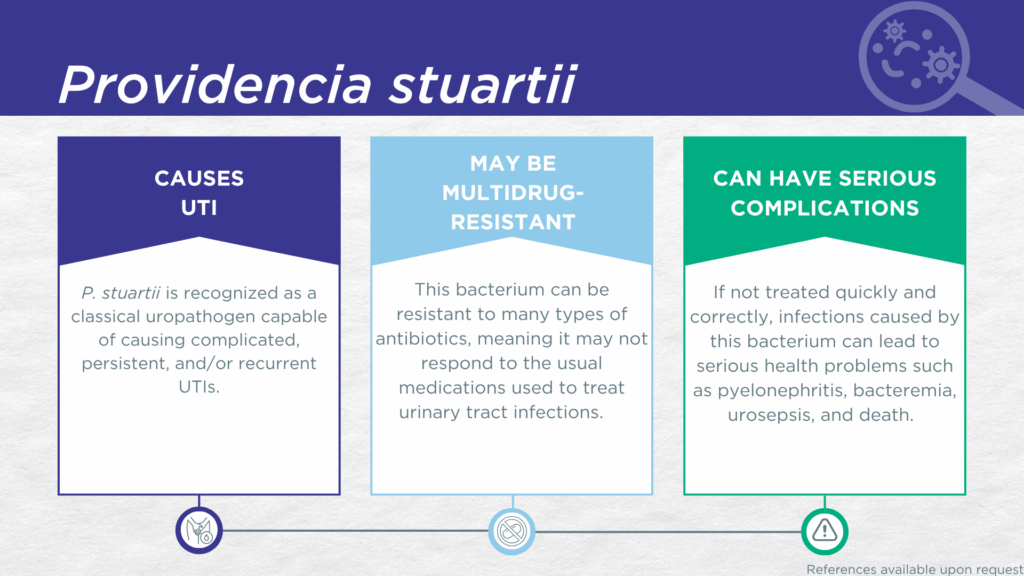P. stuartii

Emery Haley, PhD, Scientific Writing Specialist
Providencia stuartii
Clinical Summary
- P. stuartii is recognized as a classical, urease-variable, gram-negative, biofilm-forming, uropathogen.
- P. stuartii is primarily associated with complicated and persistent catheter-associated or hospital-acquired UTIs, especially among older adults with multi-morbidity.
- In symptomatic UTI patients, P. stuartii:
- Is not a contaminant (is found in catheter-collected urine specimens).
- Is viable (can grow out on culture).
- Reported severe complications of P. stuartii UTI include xanthogranulomatous pyelonephritis, bacteremia, urosepsis, and death.
- Multidrug-resistant P. stuartii is a significant global health threat.
Bacterial Characteristics
Gram-stain
Gram-negative
Morphology
Bacillus
Growth Requirements
Non-fastidious (grows well in standard urine culture conditions)
Facultative anaerobe
Nitrate Reduction
Yes
Urease
Variable
Biofilm Formation
Yes
Pathogenicity
Colonizer or Pathobiont
Clinical Relevance in UTI
P. stuartii is a gram-negative, urease-variable,[1] bacterium with potent biofilm-forming capabilities. It is a classically recognized uropathogen, particularly well-known for its association with catheter-associated UTIs (CAUTIs) and hospital-acquired UTIs (HAUTIs) particularly among older adults and individuals with multiple comorbidities.[2,3]
P. stuartii is infamous for forming multidrug-resistant, polymicrobial, biofilms on indwelling urinary catheters.[4,5] In preclinical studies P. stuartii demonstrated synergism with P. mirabilis, including increased urease activity, urolithiasis, cell/tissue damage, and bacteremia.[4,6,7] In contrast, P. stuartii has been demonstrated to exhibit antagonism with Enterococcus species, E. coli, and M. morganii.[6]
The predilection of P. stuartii for forming multidrug-resistant biofilms results in difficult-to-treat complicated and persistent UTIs. In a study of older adult males and females with clinically suspected complicated UTI, P. stuartii was detected in both midstream voided and in-and-out-catheter collected specimens indicating that it was truly present in the bladder, not simply a contaminant picked up during voiding.[8]
Although not considered one of the six highest priority “ESKAPE” pathogens, the World Health Organization (WHO) has included third-generation-cephalosporin-resistant and carbapenem-resistant Enterobacterales, including P. stuartii, in the “critical” group of the 2024 Bacterial Priority Pathogens List (BPPL).[9] Reported severe complications of P. stuartii UTI include xanthogranulomatous pyelonephritis, bacteremia, urosepsis, and death.[10–12]
Together, these findings indicate that P. stuartii should be seriously considered as a uropathogen and demonstrate the value of detecting this organism, particularly in individuals with indwelling catheters or other risk factors for complicated UTI.
Treatment
Evidence of Efficacy (Checkmarks): Ampicillin/Sulbactam, Cefepime, Ciprofloxacin, Levofloxacin, Meropenem, Piperacillin/Tazobactam, Sulfamethoxazole/Trimethoprim, and Trimethoprim.
- BacDive | The Bacterial Diversity Metadatabase Available online: https://bacdive.dsmz.de/ (accessed on 11 February 2025).
- Rajni, E.; Jain, A.; Garg, V.K.; Sharma, R.; Vohra, R.; Jain, S.S. Providencia Causing Urinary Tract Infections: Are We Reaching a Dead End? Indian J. Crit. Care Med. : Peer-Rev., Off. Publ. Indian Soc. Crit. Care Med. 2022, 26, 446–451, doi:10.5005/jp-journals-10071-24163.
- Rus, M.; Licker, M.; Musuroi, C.; Muntean, D.; Vulpie, S.; Magiar, O.; Sorescu, T.; Musuroi, S.I.; Voinescu, A.; Baditoiu, L.M. Association of Proteus Mirabilis and Providencia Stuartii Infections with Diabetes. Medicina 2022, 58, 271, doi:10.3390/medicina58020271.
- Johnson, A.O.; Forsyth, V.; Smith, S.N.; Learman, B.S.; Brauer, A.L.; White, A.N.; Zhao, L.; Wu, W.; Mobley, H.L.T.; Armbruster, C.E. Transposon Insertion Site Sequencing of Providencia Stuartii: Essential Genes, Fitness Factors for Catheter-Associated Urinary Tract Infection, and the Impact of Polymicrobial Infection on Fitness Requirements. mSphere 2020, 5, e00412-20, doi:10.1128/msphere.00412-20.
- SILVA, S.M.D.; RAMOS, B.A.; SÁ, R.A.Q.C.D.; SILVA, M.V.D.; CORREIA, M.T.S.; OLIVEIRA, M.B.M.D. Investigation of Factors Related to Biofilm Formation in Providencia Stuartii. An. da Acad. Bras. Ciências 2022, 94, e20210765, doi:10.1590/0001-3765202220210765.
- Gaston, J.R.; Johnson, A.O.; Bair, K.L.; White, A.N.; Armbruster, C.E. Polymicrobial Interactions in the Urinary Tract: Is the Enemy of My Enemy My Friend? Infect Immun 2021, 89, doi:10.1128/iai.00652-20.
- Armbruster, C.E.; Smith, S.N.; Yep, A.; Mobley, H.L. Increased Incidence of Urolithiasis and Bacteremia During Proteus Mirabilis and Providencia Stuartii Coinfection Due to Synergistic Induction of Urease Activity. The Journal of Infectious Diseases 2014, 209, 1524–1532, doi:10.1093/infdis/jit663.
- Wang, D.; Haley, E.; Luke, N.; Mathur, M.; Festa, R.; Zhao, X.; Anderson, L.A.; Allison, J.L.; Stebbins, K.L.; Diaz, M.J.; et al. Emerging and Fastidious Uropathogens Were Detected by M-PCR with Similar Prevalence and Cell Density in Catheter and Midstream Voided Urine Indicating the Importance of These Microbes in Causing UTIs. Infect. Drug Resist. 2023, Volume 16, 7775–7795, doi:10.2147/idr.s429990.
- 2024 WHO Bacterial Priority Pathogens List (WHO BPPL) Available online: https://iris.who.int/bitstream/handle/10665/376776/9789240093461-eng.pdf?sequence=1 (accessed on 18 March 2025).
- Xu, Z.; Cai, T.; Zhang, X.; Wu, J.; Liu, C. Xanthogranulomatous Pyelonephritis Infected with the Providencia Stuartii: A Case Report and Literature Review. BMC Nephrol. 2021, 22, 356, doi:10.1186/s12882-021-02565-x.
- Edwards, F.; Edwards, K.H.; Tabah, A.; Harris, P.N.A.; Laupland, K.B. Differentiation of Providencia Species Bloodstream Infections: A Population-Based Analysis. Diagn. Microbiol. Infect. Dis. 2025, 111, 116602, doi:10.1016/j.diagmicrobio.2024.116602.
- McHale, P.J.; Walker, F.; Scully, B.; English, L.; Keane, C.T. Providencia Stuartii Infections: A Review of 117 Cases over an Eight Year Period. J. Hosp. Infect. 1981, 2, 155–165, doi:10.1016/0195-6701(81)90024-4.
Dr. Emery Haley is a scientific writing specialist with over ten years of experience in translational cell and molecular biology. As both a former laboratory scientist and an experienced science communicator, Dr. Haley is passionate about making complex research clear, approachable, and relevant. Their work has been published in over 10 papers and focuses on bridging the gap between the lab and real-world patient care to help drive better health outcomes.